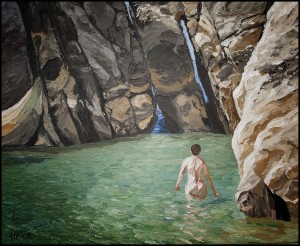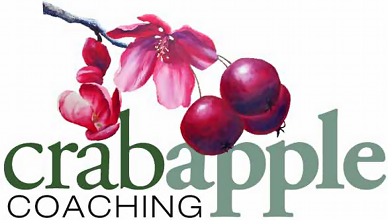 Helen, Heading Out (9)
Helen, Heading Out (9)
A series of articles about recreating identity after an all-consuming career
By Helen
University Professor of English and Women’s Studies
Retired August 2012 at age 63
The thing about art is that life is in no danger of being meaningless. (Robert Genn)
Underfoot
I have a friend who kept working because her husband retired, and she would find it difficult to be at home full time with him constantly underfoot. I had no such worries about my own retirement, since my partner Thomas and I had spent stretches of workdays together – as academics we sometimes worked at home – and research summers and sabbaticals as well. Besides, our offices were at opposite ends of the house.
What I had feared was that, without the stimulus of the workplace, we would be deprived of independent input and would lack new things to talk about. But as Thomas said recently about that danger, “we can only hope.” Apparently what has happened is that I have become a babbler. My friends and art group and pagan group and women’s group and community events and books provide me with a great deal to recount. And Thomas is so often immersed in writing, reading, or practising music, that he either doesn’t hear me or doesn’t appreciate being interrupted.
Not long ago Thomas reported that I had just disrupted his television watching fourteen times. On the Internet, particularly Facebook and emails, I find much of interest, not just photos of moose in swimming pools, however endearing, but also accounts of outrageous laws passed in Texas or tips by fellow writers or news of corporate wrongdoing. Some I feel compelled to share. When a friend complained at Women’s Week of her husband’s interruptions, I reported Thomas’s complaint, and shortly thereafter she described her husband as “doing a Helen.”
If I ask Thomas whether I talk too much or aimlessly, he refuses to answer, comparing the question to that loaded query about whether one’s butt is too fat. But something has changed, and that, for me, may be the biggest surprise yet about retirement. If someone was going to be underfoot, I didn’t expect it to be me.
By the same token, Thomas has taken up horn playing, first a borrowed trumpet, then two flugelhorns and a cornet. He practises devotedly. Friends hear blatting in the background to our phone conversations. “Smile, though Your Heart Is Breaking” accompanies me to bed at night. As I said to him, “I have come to appreciate the harmonica.”
Both of us used to be kept busier and quieter by our work.
The studio
I didn’t set out to rent studio space. Quite the opposite. When Thomas and I headed over in January of 2015 to visit the workspace of an artist we’d met, I explicitly cautioned him not to think I’d be wanting a studio. In fact, I said, I want not to have a studio. Aware of my claw marks outside the painting room upstairs, as I resisted painting, I imagined that anything farther from the house, even an outbuilding, let alone something elsewhere in town, would be an even greater deterrent to getting started at the easel.
Janette and Laurie’s studio, in an old brick warehouse downtown, was inspiring. Full of paintings and easels and a black box for viewing and lighting still-life displays, it made me want to paint. Upstairs was another, cheaper studio, recently vacated; the landlord was around the corner and could show it in an hour. Janette and Laurie hoped for another artist upstairs. Still protesting, I agreed to look at the place. It was spacious, with old beams and raw wood floors and crumbling, parged brick walls. When asked about my reactions, I admitted that should I someday want a studio, this would set the standard against which future candidates would be measured. Two days later I signed a three-year lease. And another for a parking space right outside.
Setting up
The decision was intimidating. I’d been painting for twelve years, been a member of a weekly painting group for much of that time, but didn’t feel my art was ready for showing yet. A studio upped the ante. Made a claim for me as an artist. I felt a new pressure to prove myself, to paint larger canvases, and to paint them more confidently, more loosely, more productively.
The decision was also exciting. I could set about furnishing the space. Friends and family supplied tables and storage dressers and a love-seat. Thomas built a large worktable, shelves, and a bookcase, and even a working table for the shared washroom. At thrift shops, we found a microwave, toaster, glider chair, lamps, dining table and chairs, and, because I freeze my palette and smaller knife paintings in progress, we bought a new refrigerator. When I moved in my drafting table, workbench, storage rack for canvases, easels (including a large, second-hand, artist-built one named Bigfoot, which had always been too large for my spaces), paintings, brushes, and other painting supplies, the place looked exactly as a studio should look. Until I put it all together, I hadn’t realized how much I already had the makings of a large studio. I could prepare canvases, paint, play music, feed myself, sit and study the art on my easel, hang paintings, and share space with fellow artists.
My key ring, stripped upon retirement, expanded with keys to the warehouse and to my Unit D upstairs. I was in business.
The studio effect
Happily, I responded well to the adrenaline of studio ownership. I started one large painting with all the looseness I sought and soon felt little defensiveness about sharing my work with the artists downstairs or other visitors. Canvases 20” by 30” began to seem like preliminary sizes to me, as I moved on to some as large as 36” by 48”. I worked in a series, painting different views of a collapsed and rusted pier in water, and lined my walls with the results.
During breakfast, before heading out, I began an art journal where I sorted out the issues for the current painting. Whereas at my home studio, I had often delayed getting to my easel until afternoon, with my new studio I arrived mid-morning and surprised myself by having to tear myself away at 5:30 or 6:00. Over lunch, I finally got to read the art books and magazines I’d been collecting. Useful tips and expressive quotations I took home to add to my files on those subjects. I felt quite disciplined, stimulated by what I was learning and eager to sharie ideas with my fellow tenants.
My goal was to have enough paintings to show or to present to a gallery by September. Basically that meant giving up on the outdoor pleasures of summer. I was reminded of 1977 when I similarly chose to relinquish summer, working in a bikini without air-conditioning in Toronto humidity, to complete my Ph.D. dissertation in time for a job. Since retirement is a stage beyond that kind of pressure, I may rethink summers in future, perhaps painting en plein air on good days. One of my mantras right now, about living in the present, is “this is the moment I am given.” And the shining sun is hard to resist.
The studio has proved amazingly handy. Right downtown, it positions me for quick excursions for eyeglasses, medical exams, car care, postal services, and the credit union. There’s a consignment store in the same building and a lovely café down the street. (Penny pincher that I am regarding small purchases, I’ve entered the café only to study the local paintings it displays.) Best of all, Guelph’s good art store is around the corner, and I have run out for a new tube of paint, a solvent, or canvas as needed.
After the honeymoon
My output has slowed, partly because of travel – a month in Europe, ten days in the U.S – partly because I’ve been experimenting with glazing, a slower process for building a painting layer by layer. There are days when I don’t get to my art until noon or later. Although my fear was that the studio might prove chilly in winter, a heater solved that problem. But even a fan with ice in front of it didn’t get temperatures down from the low 30s Celsius one week in July. Painting distractedly at home that week confirmed the value of the studio in maintaining my focus. Next year’s heat wave I may treat as a chance to take time off and bask in summer.
My painting has gotten tighter again, requiring a new initiative, a whole new series of more impressionistic efforts. Perhaps for that reason, I’m less sure I want to show my current oeuvre. This is not discouragement exactly, as I can feel the progress I’ve made.
And, as a side effect, I’m no longer underfoot.
What it all means
I have a busy friend who would treat retirement as time off and who shakes her head at my commitment to painting every weekday. Her partner explains that art is my new job. My Chinese herbalist neighbour urges that, for health, I should be indulging in the opposite of my usual values, should be wandering, being playful, and acting silly. I have to ask myself whether I’m afraid of freedom, needing productivity to feel worthwhile, trapped by that industriousness and work ethic discussed in the September issue of the Crabapple Coaching newsletter. Am I striving for a new success, as a professional artist, rather than painting for its own sake?
At the same time, I lie awake eagerly creating better paintings in my head than I can get on canvas. Sometimes, when sleeping, I dream of painting. When I travel, images that I’m unable to capture by camera or memory tantalize me. More painfully I’m tormented at times by my inability to realize my vision on canvas.
One of my friends spent this summer dying, and I grieved for her as I worked. When I looked around my studio with joy in my completed paintings stacked against the walls and especially when I imagined more, one of the regrets I felt for her was her loss of just such future possibilities.
The other day I felt sheer pleasure in the colours I was applying—a rich burnt sienna and a phthalo blue-green. No concern then about proving myself or ‘being a painter’ as opposed to painting. Just enjoyment of the process.
The studio solidifies my commitment to art, moves my retirement more firmly in that direction. And still I work on finding painting’s place in my life, as part of a balanced life. In the moment I am given.

Helen, after visiting your studio, I am amazed at how painterly everything is. The place looks just like what I imagine a studio is supposed to look like. The size of the canvasses that you are painting shows your confidence in your ability. You have definitely graduated into that thing called an artist. Most impressive. Enjoy! You deserve this happiness.
Thank you, Pauline. Coming from the artist you are, that means even more.
Helen, I can hear you go deeper into your process in this post. Moving beyond the questions and decisions of early retirement, into a new space in your life. Into living “the moment you have been given.” I loved the line at the end about applying those evocative-sounding colours!
I am trying to do that, Amy. Thanks for your encouragement.